14 min read
Top 5 Content Marketing Strategies + Trends & Challenges For 2023
All you need to know about the top content marketing strategies for 2024, plus trends to follow and challenges to prepare for.
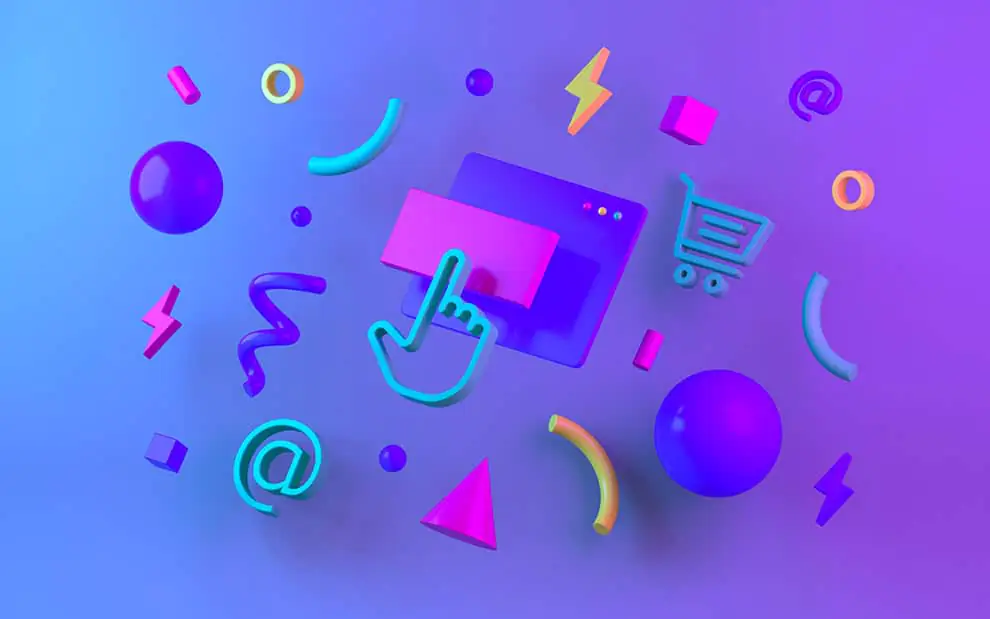
97% of marketers think their business has at least some success with content marketing, with 61% citing the value it brings to their clients as the key benefit.
With strategic content marketing, you can connect with your audience, and in turn grow both your brand and your revenue.
In this article, we address the five most effective types of content marketing strategies, their best practices and where they stand in user journey.
We’ll also cover the advantages of content marketing as a part of your business growth strategy, the latest trends and the biggest challenges in content marketing for 2024.
Have a content marketing project? Digital Silk creates results-driven strategies.
What Is Content Marketing?
Content marketing is an inbound digital marketing strategy that relies on different types of content and channels to:
Have a branding project? Digital Silk delivers end-to-end branding solutions.
- Attract clearly defined audiences/leads into a business’ sales funnel
- Improve user journeys, influencing conversion
Depending on the format, purpose and delivery channel, content marketing can be broken into these subsets:
- Web content
- Blogs
- Email marketing
- Digital PR
- Video marketing
- eBooks
- Webinars
- Infographics
- Podcasts
- Checklists
- Social media marketing
- Quizzes
- Lead magnets
Let’s take a look at the advantages of having a well-defined content marketing strategy and what it can do for your business.
Need help with your content marketing? Meet our content strategy experts.
Why Develop A Content Marketing Strategy?
A strategic content marketing strategy can play a key role in increasing brand visibility and generating valuable leads. Content marketing:
- Drives traffic to key landing pages
- Boosts brand awareness:
- Increases lead generation and conversion:
- Brings in revenue:
Make your marketing funnel successful by using different types of content for different stages:
Top of the funnel, to generate brand awareness:
- Info web pages
- Blogs
- eBooks
- Vlogs
- Infographics
- Webinars
- Press releases
Middle of the funnel, to educate and nurture:
- Educational resources and downloadables
- Email campaigns / Newsletters
- Video presentations
- Event videos
Bottom of the funnel, to convert:
- Comparison sheets
- Case studies
- Testimonials
- Review pages
- Email campaigns / Abandoned cart recovery
Explore this case study and see how DigitalSilk optimized the website content of one of our clients and increased website sessions by 118%.

5 Best Content Marketing Examples That Work In 2024
1. Web Content Strategy
Different kinds of web content can be used as a marketing strategy, but in this particular segment, we will focus on the one with the biggest potential – web copy.
Engaging web copy can help you build relationships, nurture leads and influence potential buyers. The goal is to answer the needs and desires of your audience, through your copy.
Focus on creating various types of content for the different stages of the sales funnel, taking into account the needs and expectations of users in each stage.
From awareness to consideration and conversion, use your web copy across the sales funnel to educate your audience about your services, share your message and influence prospects to make a final purchasing decision.
Web copy best practices include:
- Make your audience feel at home: To deliver a great copy, understand your audience and their reasons for browsing your brand’s website. Define their pain points and needs and deliver exactly the type of content they are looking for at each stage.
- Be brief: To create copy packed with value, use short sentences and small paragraphs. Focus on what’s really important to your audience. Don’t forget that most users only skim through your web pages.
- Highlight your unique value proposition: Motivate your readers to keep engaging with your business by showing them what makes your offers better than your competitors’.
- Present your unique brand personality: To ensure brand retention and memorability, use a consistent tone of voice to help your customers identify with your brand’s values and personality.
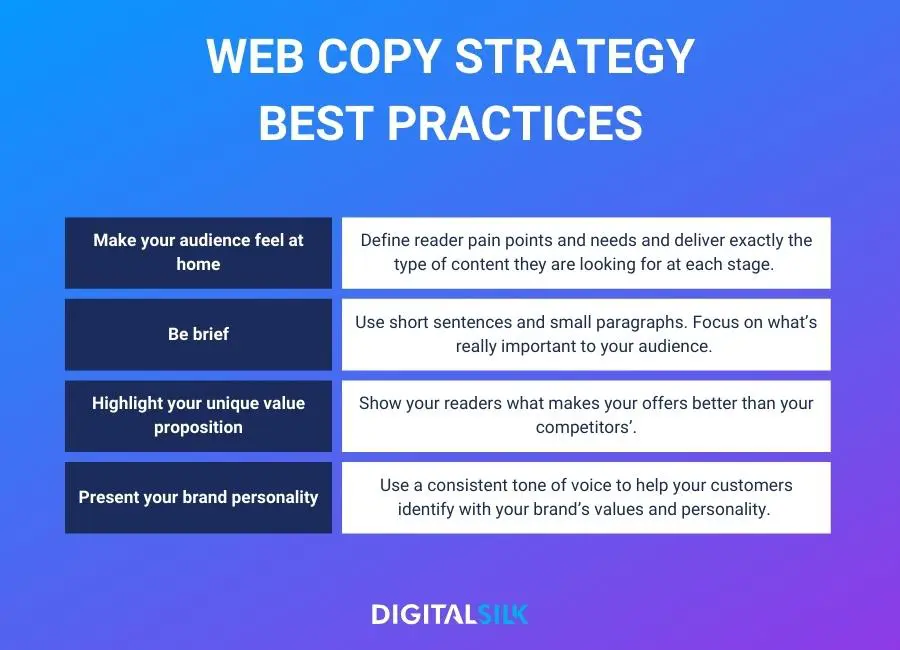
2. Blog Content Strategy
Blogging as a content marketing strategy has multiple benefits:
- It helps your website’s SEO
- It attracts leads through organic search results
- It nurtures leads by providing quality content
- It helps your readers make well-informed decisions about your brand and products
- It shapes brand reputation by positioning your business as an authority/thought leader
There are several types of blogs you can consider for your brand:
- Thought leadership & industry insights
- Newsroom
- Instructional (product use and other how-to’s)
- Inspirational
- Recruitment
Thought leadership content created by industry experts is, in particular, one of the most effective ways for generating leads,
B2B tech companies can use blogging content to generate interest and attract new leads into the sales pipeline.
Other types of content, such as case studies, demo videos, product descriptions, tutorials and client testimonials are also highly effective, especially when combined with blog articles.
So where does blogging belong in the marketing funnel?
Blogs belong at the top – or, at the beginning – of your conversion funnel, where your objective is to educate your potential customers who come into contact with your business for the first time.
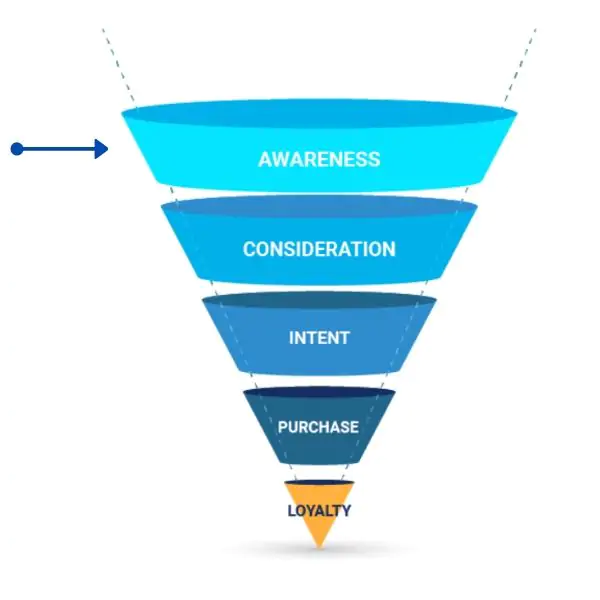
At this stage, use blogging to raise your brand awareness and turn casual website visitors into loyal customers.
Blogging best practices include covering both evergreen techniques and rising trends based on the evolution of search engine algorithms and changes in audience behavior.
Blogging best practices include:
- Search Engine Optimization
- Long-form content
- “Skyscraping” technique
- Data-driven blogging
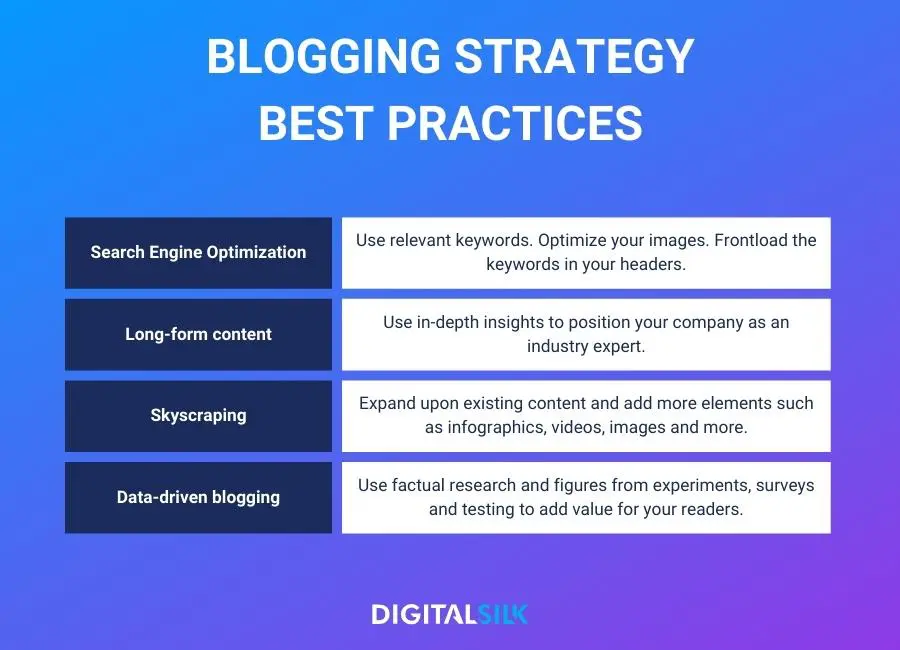
3. Email Marketing Strategy
By 2025, emails around the globe are expected to increase to 376.4 billion per day.
And, research has shown that effective email marketing can bring an average return of $36 for every $1 spent.
According to Mailchimp, emails have an average open rate of 21.33% and a 2.62% CTR.
However, the consumer behavior within your industry will impact this.
For example, Mailchimp found that while agriculture and food services see open rates of 23.31% and a 2.94% CTR, beauty and personal care receive a 16.65% open rate and 1.92% CTR.
Evidently, this shows the potential for higher levels of consumer connectivity through email marketing campaigns in the agriculture and food than in beauty and personal care.
Where does email marketing belong in the marketing funnel?
Email marketing is essential to any digital marketing funnel. That’s why 64% of small businesses use email marketing to reach their customers.

While you can use email marketing at all stages of the marketing funnel, it’s most effective in the middle and bottom of the funnel areas, in customer acquisition and retention.
Make sure you keep an up-to-date email list of both your new visitors and your existing customers.
Email marketing best practices include having an up-to-date email list of your visitors and existing customers, and using:
- Bold calls-to-action: Bring your recipients one step closer to the conversion point by leading them to your website or motivating them to complete a purchase or download an eBook.
- Engaging copy: Catchy subject lines are a no-brainer, but it’s also important to invest your time into the body copy of an email to make it to-the-point, concise and engaging.
- Segmenting: Divide your email lists into targeted groups according to common traits, needs and habits.
- Personalization: Send personalized messages to specific audience segments to better content with each potential lead, depending on where they’re at in the funnel.
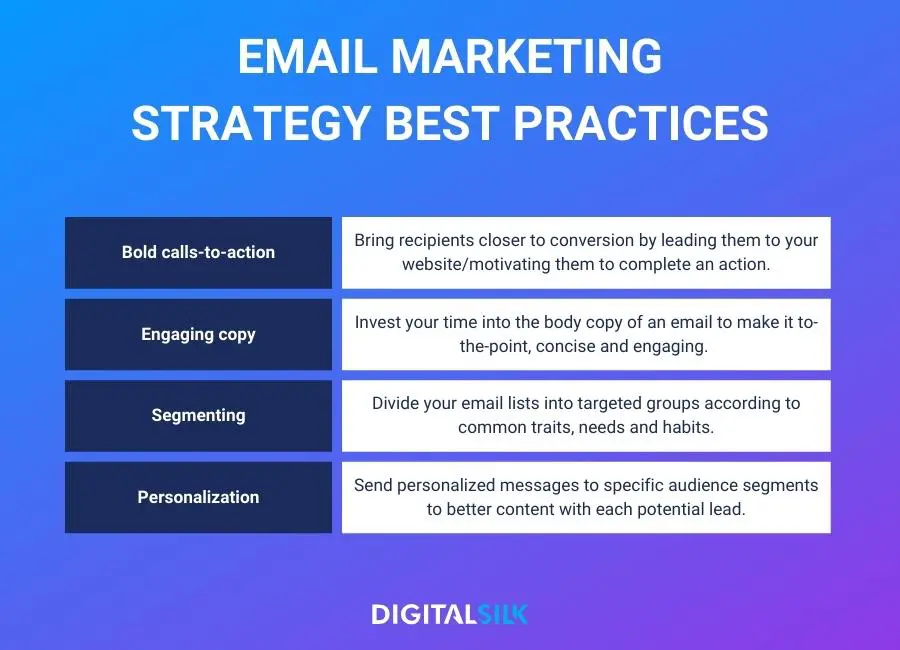
4. Digital PR Strategy
Digital PR increases brand awareness by using online methods to reach a broader audience that traditional PR may not be able to reach.
It relies on search engine optimization, influencer outreach and social media to improve online presence and visibility.
Use these Digital PR tactics to improve your web presence:
- Create online press releases with relevant links that lead to your website
- Nurture relationships with online journalists and bloggers to generate online coverage
- Organize interviews
- Foster influencer marketing and outreach to increase mentions on social media and blogs
- Manage online reviews and comments
The benefits of effective digital PR include:
- Increased website traffic
- Becoming an authority in an industry
- Improving search engine optimization
- Boosting brand image
- Generating leads and sales
So, where does digital PR belong in the marketing funnel?
Digital PR is about raising awareness using traffic to the campaign or boosting the brand’s visibility by improving your ranking positions, which is why it belongs to the top of the marketing funnel.

Digital PR best practices include using its cross-funnel potential:
- Use funnel campaigns: Use digital PR as the primary interaction point with your consumers. Combine PPC techniques with PR, such as creating strategic ads to drive tangible ROI for your digital PR campaigns.
- Integrate PR with SEO: Build links to each page and use SEO techniques to increase rankings for a certain keyword.
- Repurpose your content: Transform your digital PR to be published on various platforms and repurposed into different types of PR content such as a newsletter, guest blog, infographic or video.
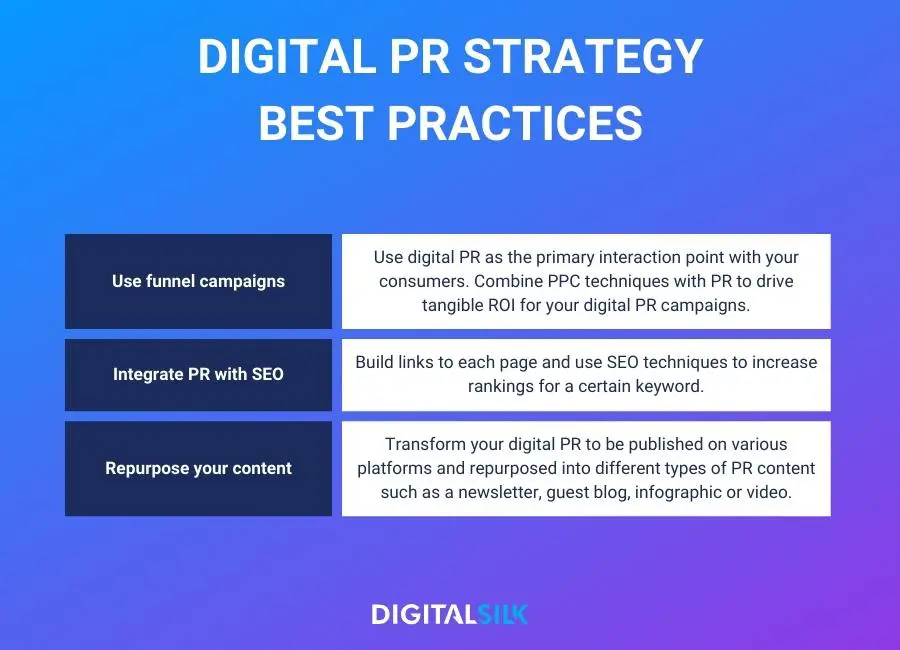
5. Video Marketing Strategy
Use video marketing to promote your brand, increase engagement on digital channels and educate prospects about your offering.
Video marketing is proven to be one of the most effective types of content.
And, 93% of consumers say videos help them make buying decisions.
Video marketing can help compliment email marketing (according to Super Office, including ‘video’ in your email subject lines increases CTRs by 6%), encourage social shares and build trust and credibility with your brand.
Different types of videos in content marketing include:
- Demo videos
- How-to videos
- Expert interviews
- Case studies
- Customer testimonials
- VR videos
- Personalized messages
- Live videos
- Explainer videos
Where does video marketing belong in the marketing funnel?
Video marketing usually stands at the top of the conversion funnel due to its educational nature.
However, it can belong at any stage of the conversion funnel and user journey, depending on the content it contains. Video content can be adjusted to the specific needs of a prospect on different stages of their journey.

Video marketing best practices
- Establish a clear goal
- Optimize videos for SEO
- Use a call-to-action
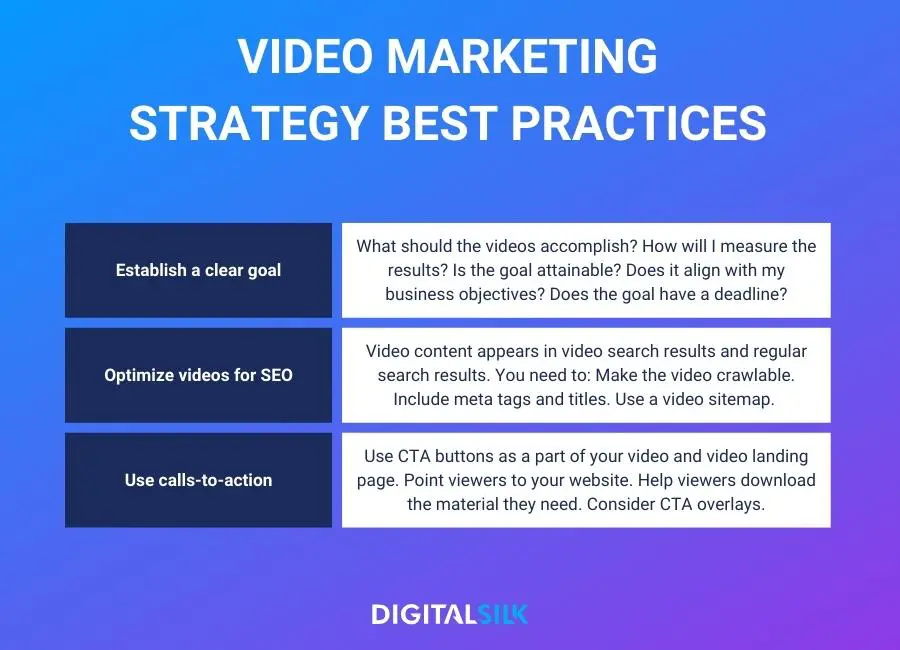
5 Content Marketing Trends You Should Adopt In 2024
As digital marketers find new ways to engage their audience and deliver their messages, new trends are developing that enhance the content marketing game.
These five trends will dominate in 2024:
